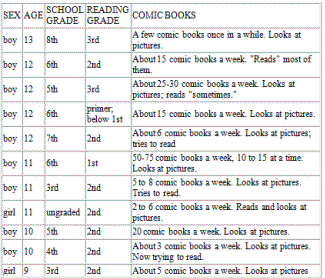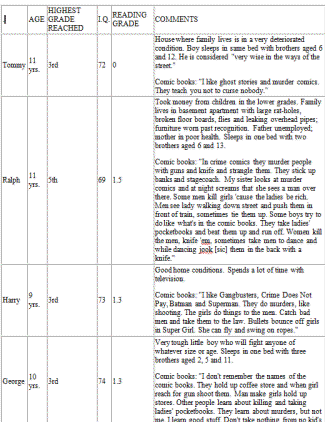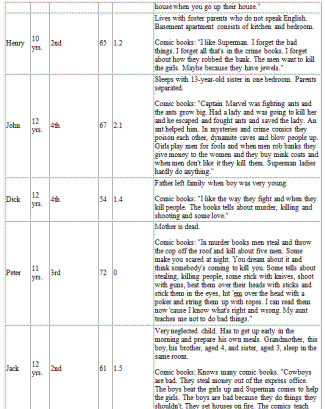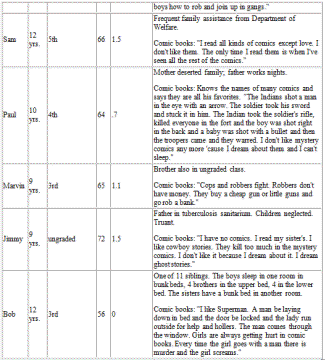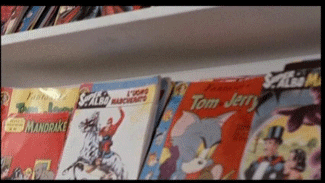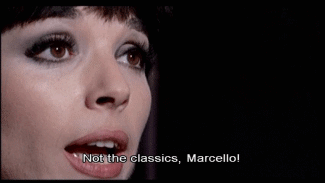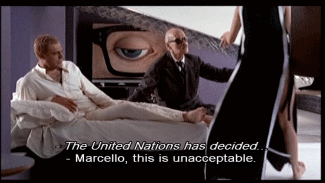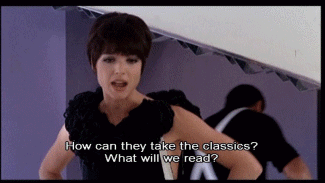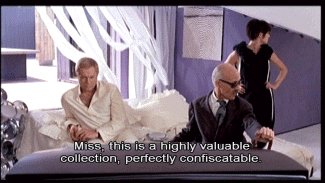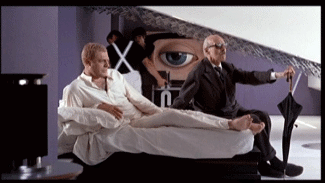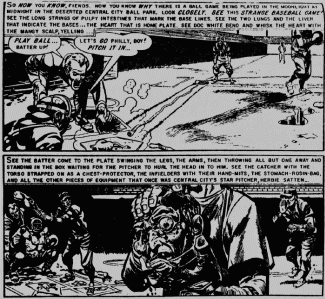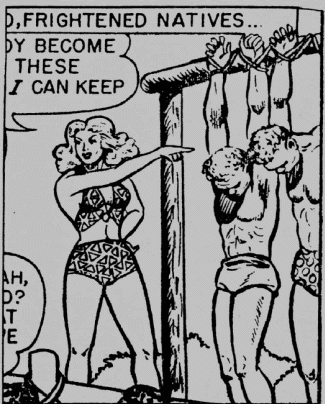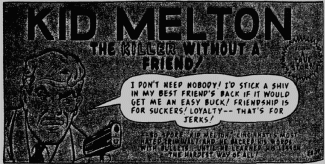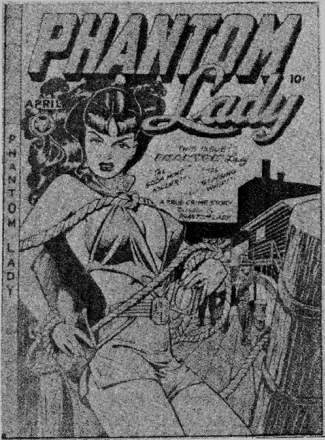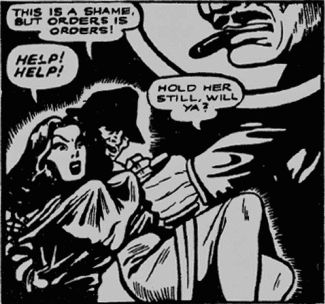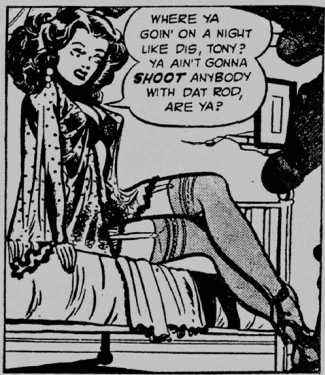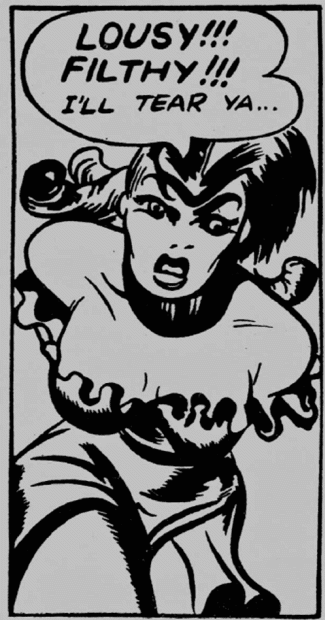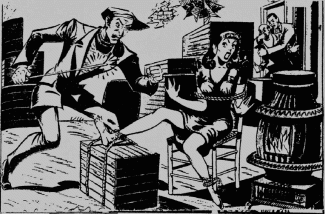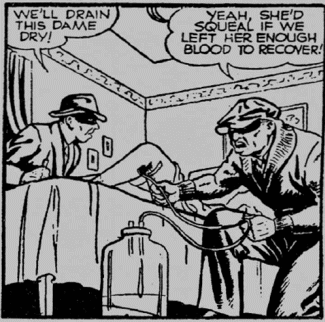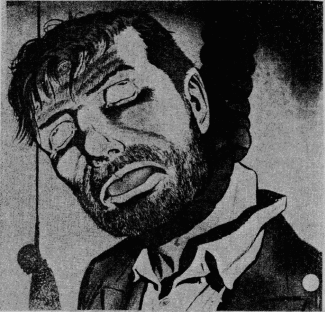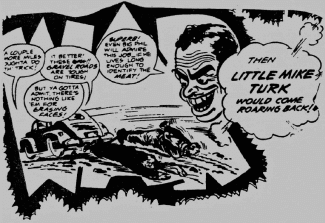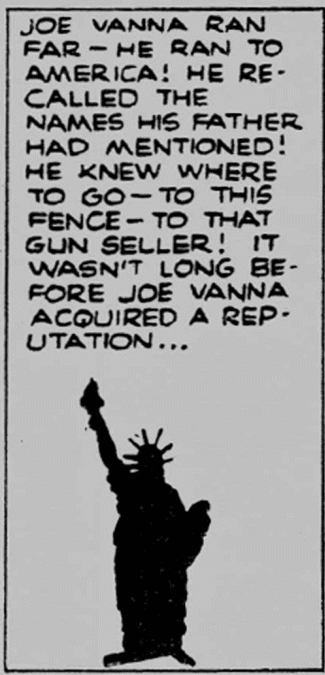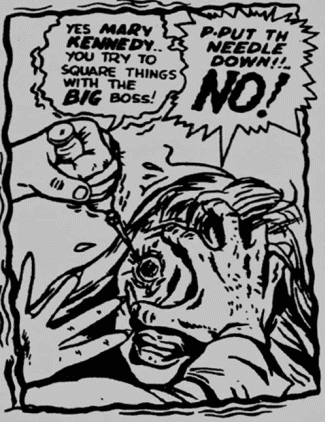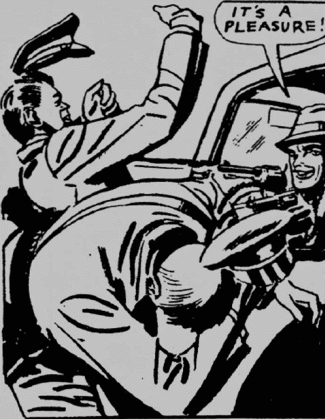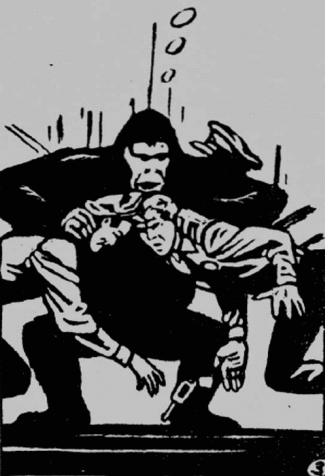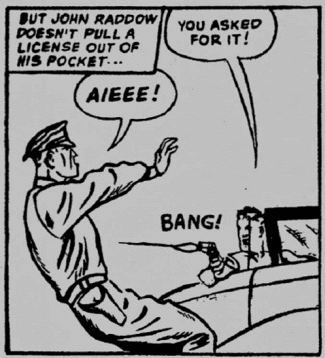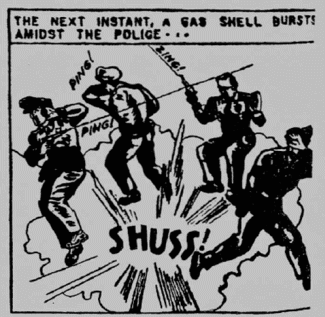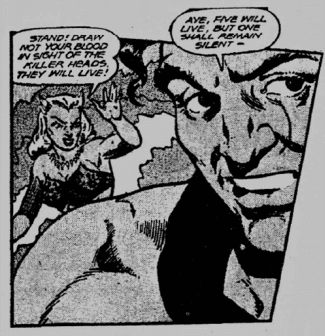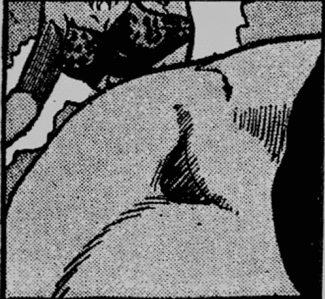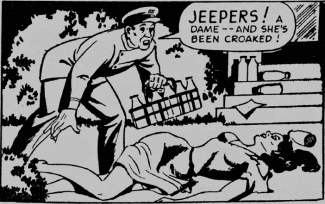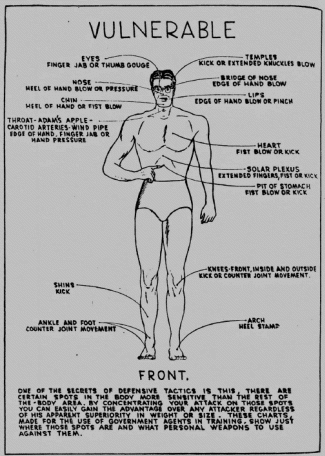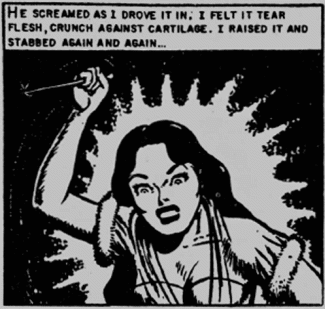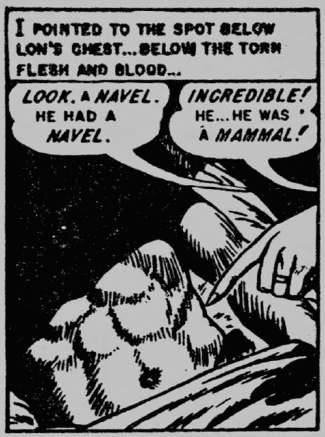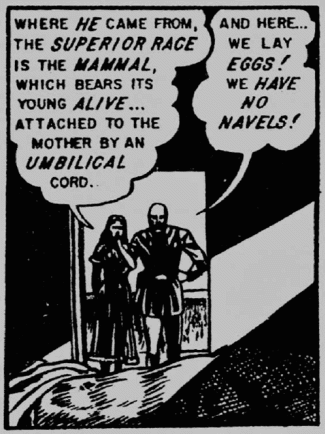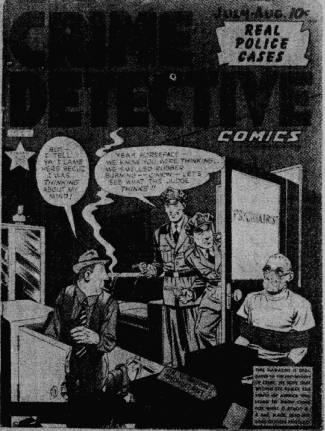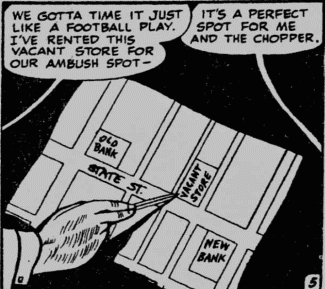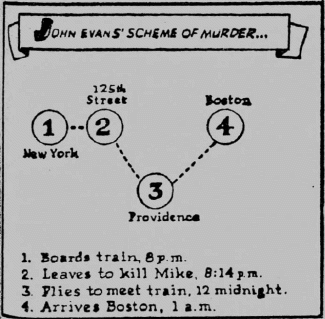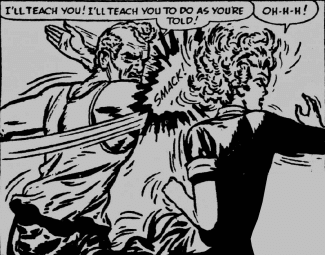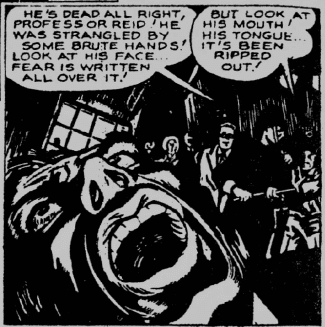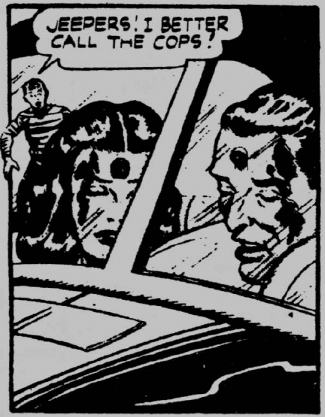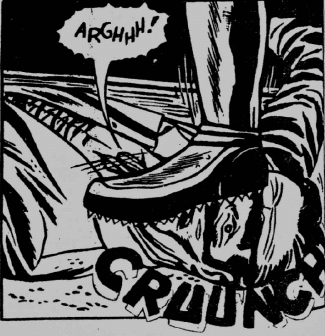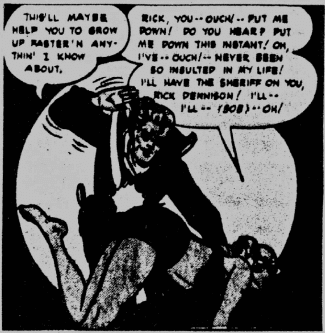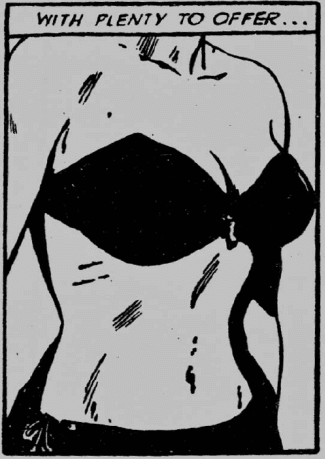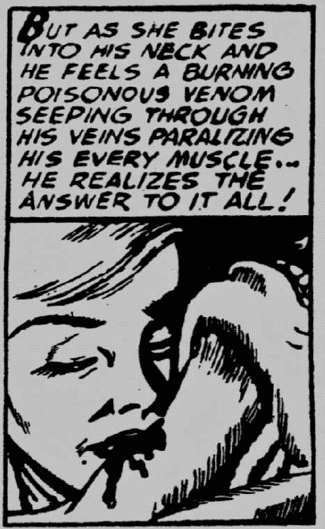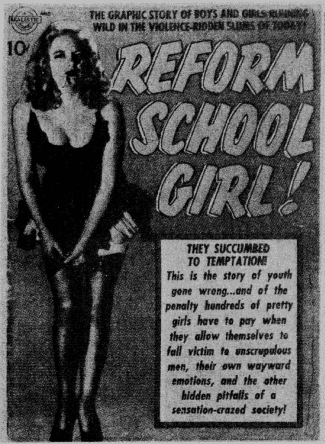3. The Road to the Child
Methods of Examination
"And then one should search . . . for connections, conditions and situations that have acted at once or slowly, and with which perhaps the origin of the abnormal deviation may be justifiably linked . . . Moreover, it is necessary to understand why these conditions and situations have brought about such results in the patient, when in another person they would occur without the slightest effect; and furthermore, why they all lead in the case of one person to just such an abnormal complex, while in another to a totally different one."
-- Pavlov
The problem of what comic books do to children, or rather what they have already done to a whole generation, is three-fold. Its solution requires a knowledge of comic books, of the minds of children, and of the processes, the mechanisms, by which comic-book reading influences children. When, for example, a young child hangs himself and beneath the dead child is found an open comic book luridly describing and depicting a hanging (as has happened in a number of cases), the mechanics of the relationship between the two have to be investigated, e.g. the processes of imitation and experimentation in childhood.
To study the psychological effects of comics on children one must first have more than a superficial and scanty knowledge of what is in them. For if in children's nightmares or in their play or in their productions in psychological tests, any association or reference occurs to the "Venusians" or "Voltamen," to "a syntho-shade" or to the precise instructions on how to "case wealthy homes" for burglaries, you will not understand the response if you do not know the stimulus.
Several times when some of the earlier results of our research were presented, somebody from the field of child care would get up to state that he had never seen a child who was influenced by comic books. This statement in itself is preposterous, of course. For nothing that occupies a child for several hours a day over a long period can be entirely without influence on him. The trouble with these arguments was that these people had not studied the contents of comic books, had failed for years to take notice of their very existence as a potentially harmful factor, and had never examined children for their influence. Or the proud protagonists of negative results had -- without realizing the implications -- even encouraged children to read crime comic books as recreation and proper mental nourishment!
The same is true for superintendents of institutions for delinquents who have stated their opinion that there is no connection between the behavior of juveniles and crime-comic-book reading. How would they have found out, sitting at their desks far removed both physically and psychologically from the lives of the inmates, to whom for years in these institutions crime comic books have been fed as a steady diet? One Lafargue psychiatrist who worked for a time in a big state reformatory for boys has vividly described how many hours these confined children spend on crime comic books (with which the reformatory is filled to the brim) and his dismay at seeing how children who had got into trouble while reading many crime comics were sentenced to years of incarceration to read even more of them. That is one of the paradoxes of the social problem of crime comic books: that those with authority over children have for years neglected to pay any attention to this literature, which for many children is practically their only reading, have prescribed it for children in their charge as remedy and recreation, have paid no attention to the consequences, and now state as their professional opinion that comic books do not do any harm. Those are not the ways of science.
Such opinions show that these reformatory officials not only do not have enough contact with their charges, but also are not sufficiently acquainted with the observations of their employees. A number of psychologists and social workers employed in reformatories have told us over the years what an unwholesome influence comic books are in these institutions. Others have told us that supervisors in reformatories -- like many parents -- give lots of crime comics to children in order to keep them quiet. As an example of the problems comic books present in reformatories, one social worker stated that "when it came to drawing, the boys drew pictures from the comic books that showed violence or a preoccupation with unhealthy sexual attitudes."
The method we have used is to read, over the years, very many comic books and analyze and classify them from as many points of view as possible. Many different patterns can be discerned in them, according to publisher, writer, draftsmen, the prevailing trend and the special genre. A lot of comic books have come to us from children themselves. And if it was feasible, whenever children referred to something they had seen in a comic book we asked them to bring us that particular comic book. When they no longer had it, we added its name to a list of "wanted" comics and tried to get it later on.
It is not scientifically sound to narrow down the problem to whether the influence of comic books is just "good" or "bad." That cannot be a sound starting-point. The question is, do they have a discernible influence, and if they have how does it work, how intense and lasting is it, and in what fields and regions of the child's mind does it manifest itself. This is exactly how I started.
When Time magazine, at one stage of my investigations, reported my statement that the violence of crime comic books is a contributing factor to the increasing violence in juvenile delinquency, the father of a boy of four wrote a critical letter to the magazine in which he said, "It occurs to me that Dr. Wertham takes a child's mind too seriously." Is it possible to take a child's mind "too seriously"? Is anything to be gained by the current cheap generalization that healthy normal children are not affected by bad things and that for unhealthy abnormal children bad things do not make much difference either, because the children are bad anyhow? It is my growing conviction that this view is a wonderful excuse for adults to do whatever they choose. They can conceal their disregard for social responsibility behind a scientific-sounding abstraction which is not even true and can proceed either to exploit children's immaturity or permit it to be exploited by whole industries.
In the ordinary process of education children are told that they should listen and learn. In the psychiatric investigation of children's minds just the opposite is true: it is we who have to listen and learn. And this is what I and my associates have tried to do throughout our research.
Child psychologists often publish results of studies based on the questionnaire method. They take a group of children and ask them: "Do you do this (or that)? How often do you do it? Do you read this (or that)? What do you like better (this or that)?" -- and so on. This questionnaire method is inadequate. To ask children a series of simple questions and expect real enlightenment from their answers is even more misleading than to carry out the same procedure with adults. The younger the child, the more erroneous are the conclusions likely to be drawn. Children love to express themselves, but giving hard and fast answers to hard and fast questions is neither their favorite nor their natural method. Even if they do their best, the procedure is crude and leaves out all the finer shades of the dynamics of childhood thinking. On this premise we decided from the very beginning not to rely on any single method, but to use all the methods of modern child psychiatry which were suitable and possible in the individual case.
If one wants to go beyond narrow formal questions and intends to include the largest variety of different children, it would be a top-heavy procedure to start and execute a study devoted to one factor such as comic books alone. For this reason we have from the beginning integrated our studies of comic books with our general routine work in mental hygiene and child psychiatry. Good clinical work is good clinical research. In other words, in doing thorough clinical work the psychiatrist cannot help reaching into unexplored no-man's land. It will happen again and again that in cases that seem baffling in their symptomatology, refractory to treatment or show unusual manifestations, he will come up against new factors that are not in the books.
Starting on such a wide basis, the material available for this study covered the largest cross-section of children as they are seen in mental hygiene clinics: children who were referred by every variety of public and private child-care agency; who had come to the attention of the juvenile part of the Police Bureau or the Children's Courts; who were seen in the course of private practice or were confined for observation in psychiatric wards for adolescents, or were confined for physical diseases in pediatric wards, or seen in pediatric clinics. A large proportion of children were normal children who came to our attention for some social reason, including children of superior endowment, who were candidates for scholarships for special educational facilities. The upper age limit of children in whom we were most interested (although we did not adhere to it rigidly) was sixteen. Data were obtained also from older teen-agers and adults referring to their earlier comic-book-reading stage.
The reasons given why contact was sought for these children with physicians or psychiatrists or psychologists or social workers usually did not include any reference to comic books. But from the very beginning there were cases where the reading of comic books was part of the complaint. In these cases the main complaint was what the Reverend Shelton Hale Bishop, an authority on juvenile gangs, called the "extreme avidity" of their comic-book reading. "These comics may be a counterpart of what youngsters see in the movies," he said, "but at least they cannot live with the movies day in and day out as they do with their comics. They take them to bed with them. They walk along the street on their way to school reading them. When they go on an outing for sheer fun, for vacation, along goes an average of five or six magazines per child, and an abnormal amount of attention is given them. They read them going; they read them there; they read them coming home; they swap them; so that the whole thing borders on extreme and abnormal avidity."
If all the children who pass through a period of this "extreme and abnormal avidity" were really sick children in the first place, as experts of the comic-book industry would have us believe, this would be a sick generation. But such arguments are so superficial, and so evidently special pleading, that the only thing worth noting about them is that so many adults are naive enough to give them credence. It is necessary to analyze the comic books themselves, the children in relation to them and the social conditions under which these children live.
The cases in which comic books figured in the original complaint can be illustrated by a typical statement that we have heard many times. A social acquaintance asked me about his nephew: "My sister has a little boy. He reads comic books all the time. And I've seen him -- it is all the time! He lives in one of those dream worlds. He's always interested in these books. All his concentration goes to that. All his excitement comes from these comic books. He doesn't even go out to play ball." I have never heard such a complaint about harmless animal comics.
The very fact that in the beginning we did not know the best advice to give in such cases was an added incentive to keep up our studies. The common assumption that the child must be "unhealthy in the first place" proved in most instances to have no relation at all to the facts. What was unhealthy in most instances were the comic books when we inspected them. Children, like adults, without necessarily being sick or neurotic, are different in their powers of resistance to such stimulations.
Another typical case where comic books figured in the reasons for referral was an eight-year-old boy who had suddenly begun to take money in his home. This boy was brought up in a cultured and secure home. He had been reading comic books, some of which he bought in a nearby candy store where large quantities of them were alluringly displayed. His father, a physician, told me, "He says he knows he's doing wrong, but he wants the money for comic books. He hasn't spent it on anything else. He has comic books all over the house. He reads them at the table and doesn't eat properly. Last summer when he went to camp every child had comic books and he brought a big bundle home with him. These books distract him from doing his lessons. Why, he's even gotten a sex angle from them. He told his mother that if she'd take off her blouse she'd be as pretty as a comic-book girl! What shall we do about him?" The father himself, a gentle person, had taken the drastic step of burning up all the comic books he found in his house.
Over the last few years cases of this type have greatly increased: the young child in the grip of the lure of comic books, the frustrated parent who is baffled by this invasion of his home by a powerful industry. But even so, cases that came to our attention just on account of comic-book reading form only a small proportion.
The psychiatric study of children is in general not nearly so standardized as that of adults. The so-called mental status, that is to say the formal examination for the more gross symptoms, such as disorientation or defects of judgment, or mood disorders, is not very productive. In adults we can take the life history of a patient and learn a great deal about him from his reactions to typical outer events. And we can proceed to study his inner life history as a sequence unfolding according to a certain pattern. The life history of children is not only briefer, but presents the paradox that while one can understand it only if one has a good picture of the child's environment, the story itself is an inner life history.
I have gone over many psychiatric charts of children taken in hospitals, in clinics and by consultants of private agencies. And I have often been astonished how few quotes, if any, they contain, of what the children themselves actually say.
We have given routine psychiatric examinations to children where they are interviewed by a psychiatrist. We have taken the history of the child's development from his parents, or from those with whom he has lived and who brought him up. Whenever possible, social workers have studied the child's social environment, obtained school reports, interviewed teachers, and relayed information from other agencies who had contact with the child or his family. In the same way, pertinent information was obtained from hospitals, private doctors and clergymen. In cases where courts were involved, probation reports were added to the record or probation officers interviewed.
In cases where children confided to us that they belonged to gangs and gave us permission to speak to other gang members, we made an attempt to hear their story. As much as possible we tried to ascertain the recreational influences to which children are exposed: games, community centers, radio, television, books. It is in that setting and with that perspective that we began to realize and ascertain the influence of comic books.
To establish proper circumstances which give a child the chance to express himself is difficult. Children do not like doctors' offices any more than adults do. Nor do they like being asked embarrassing questions in front of their parents. The way to gain their confidence is to treat them as persons in their own right. The paradox that this goes beyond examination and in itself is a step in therapy should not deter one. All child psychology worthy of the name is very close to educational and re-educational methods. It is in the very process of education that the child is best understood.
If one wishes to obtain the spontaneous expressions of children, it is only the amateur who attempts to exclude himself and then observe some pseudospontaneous reaction of the child. Children do not dislike authority. On the contrary, they have a strong inner urge to find and follow authorities whom they can trust. They may not always understand what is best for them, but they learn that, and a large part of a child's inner life consists in this search, disappointment, finding and retrospective correction. If the examining psychiatrist tries to eliminate himself as a personality and as an adult whom the child knows to be older and therefore more experienced, he will get only artificial results.
In children's lives other persons, parents especially, of course, but also older and younger siblings, play an important role. So it is necessary to obtain a picture of these other dramatis personae, not only as they are reflected in the child's mind, but as they really are. Interviewing younger children to hear what they have to say of a child is often very enlightening, sometimes more so than what parents say. Yet I have rarely seen in charts a quotation of what brothers or sisters have to say about a young patient. In our study of crime comic books it was interesting to see siblings because comic books are often a family affair. Younger children clandestinely or openly read the comics of their older brothers and sisters.
The application of psychological tests is apt to be overdone in a mechanical way. Yet they are indispensable to child psychiatry. The Rorschach (ink blot) Test, if expertly and judiciously interpreted, was an important tool in our study. This test consists of a series of ten ink-blot pictures. The subject is asked what he sees in them. It should not be given by itself, but should always be correlated with clinical findings and other tests. We have noticed that in Rorschach tests children may see forms that adults usually do not see. Investigated, they often turn out to be forms related to what they have seen in comic books, especially weird and horror comics, e.g. ghost forms, fantastic hands, etc. These are apt to be misinterpreted by psychologists as meaning complex-determined anxieties and phobias, whereas actually they are just reminiscences from comic-book illustrations. Here according to our findings an important inroad has been made into children's imagination and imagery, and of course also into their actions.
A boy of ten came to the Clinic with the main complaint that "he won't concentrate on his schoolwork." He had previously had a psychiatric examination through a public social agency where he received the customary cliche diagnosis of "deep emotional disorder" and where it was noted that "his mother is seductive and stimulating to him." A Rorschach report stressed his "underlying feelings of hostility and destructiveness" and stated that the boy "is attempting to repress his hostile and destructive tendencies at the expense of spontaneity."
When we studied this boy carefully, we found that he had a difficult father, but the imagery of his destructiveness came mainly from the fact that he was an inveterate reader of "murder comics." His real life difficulty was that he could not read. ("I don't read comic books. I only look at pictures.") Thus the correct interpretation of the Rorschach Test responses needs a knowledge of the whole picture and of the period in which the child lives. Circumstances in the United States today are different from those in the Switzerland of decades ago when Dr. Rorschach devised and worked out his test.
When pronounced hostile and threatening images are found in the Rorschach Test, they usually come from one of three causes. First, a special atmosphere of hostility in the early environment, parents' fights and family discords, or gang-dominated schools or neighborhoods. Secondly, such images occur in a relatively very small number of really psychotic and psychopathic children. Thirdly, they are derived from outside influences such as comic books. In the frequently hackneyed routine of the examination of children, ingrained tendencies or the narrower family situation are usually held responsible. But careful examination of factors shows usually a combination of the first and third groups. An eleven-year-old boy of superior intelligence showed in the Rorschach Test (and in his drawings) strife, hostility and threatening images. He lived with parents who for years had gone from battle to battle, and from court to court. In addition, he was steeped in crime-comics lore:
"My mother doesn't like me to read crime comic books, but I see them anyhow. I like Superman, Penalty. I like the Jumbo books. They have a lot of girls in them. There is a lot of fighting in them. There are men and women fighting. Sometimes they kill the girls, they strangle them, shoot them. Sometimes they poison them. In that magazine Jumbo they often stab them. The girl doesn't do the stabbing very often, she gets stabbed more often. Sometimes the girls stab the men, sometimes shoot them. I read one comic book where they tie people to the trees, tie them in front of stampeding herds. They tie them to the trees, then cut the trees and the sap runs over that person and the bugs are drawn to that sap, then they eat the people. Sometimes they torture girls the same way, by stabbing and beating them. They throw them in rivers and make them swim where alligators come. Sometimes they hit them with weapons on the back. They don't have much on when they hit them with weapons. It excites me a little bit."
Is it not natural that the Rorschach of the boy shows hostility and aggression?
The Rorschach Test is a valid scientific method. I was one of the first psychiatrists to use it in this country and published research on it over twenty years ago. In my experience with children and adults I have found it a revealing auxiliary method. But in recent years it has been too often used uncritically, interpreted with the bias of a purely biological determinism, leaving out all social influence, and given by psychologists with either faulty clinical orientation, or with no clinical orientation at all. Under these circumstances, the Rorschach Test like any other wrongly applied scientific method has given wrong results. It has been used, for example, to bolster the conception of more or less fixed psychological-biological phases of childhood development. And this is a conception which has caused parents whose children do not conform to textbooks a great deal of anxiety. It has led psychologists to socially unrealistic generalizations. A recent text on children's Rorschach responses describes as the "essence" of the average normal seven-year-old child a most abnormal preoccupation with morbidity, mutilation, pain, decay, blood and violence. But that is not the normal essence of the average American child, nor of any other child! You cannot draw true conclusions from any test if you ignore the broad educational, social and cultural influences on the child, his family and his street. These influences, of which comic books are just one (although a very potent one), favor, condone, purvey and glorify violence. The violent meaning of the Rorschach responses is not the norm for the age of seven; unfortunately it seems to be becoming the norm for a civilization of adults.
A popular syndicated column for parents on child behavior (emanating from the Gesell Institute) processes these findings for the popular consumption of parents. It concludes that "the environment -- the radio, movies and funny books" have nothing to do with the child's lust for gore, his love of the horrible. "We believe these preferences to be the normal expressions of the child's likes at his age." Parents who read such a misleading column are of course disarmed by the supposed evidence of such a scientific method as the Rorschach Test. They tend to blame their child or themselves and in so doing they give the industries that peddle stories and programs of violence for children a free hand.
In. the Thematic Apperception Test the child is shown a series of pictures depicting various scenes and is asked to tell stories about them. We found in some children preoccupation with stories of murder, blood-letting and violence in one form or another. But if one does not appreciate that this kind of production occurs much more in avid crime-comics readers than in other children, one is apt completely to misinterpret the test. This test also showed us that comic-book reading leaves definite traces in the child's mind which crop up as spontaneous manifestations in a projective test.
The Mosaic Test we give routinely to the children. The child has a choice of a large number of mosaic pieces of different colors and shapes. He is asked to put them on a tray and make any design he pleases. The test is very useful in a diagnosis or for ruling out of psychotic conditions, even inconspicuous and incipient ones. These tests revealed in a large series of cases that there is nothing intrinsically abnormal about those children who either became very addicted to reading crime comics or are influenced by such reading to delinquent acts. As a matter of fact, the Mosaic Test -- in conjunction, of course, with clinical findings -- indicated or confirmed our finding that those children who suffer from any really serious intrinsic psycho-pathological condition, including those with psychoses, are less influenced by comic-book reading.
Intelligence tests and aptitude tests were of course given routinely in all cases where there was any question of the adequacy of intellectual endowment and resources. For the study of the effects of comic books, complete tests for reading ability were found to be of crucial importance. Many statements about children's reading have been made off and on which are not based on a really full and specific study of reading by the various tests devised for this purpose. The harmful effect of comic-book reading on children's ability to read is a special chapter and a sorry one.
A test which is no longer used as much as it should be, the Association Test, we found particularly useful. The associations to words which are complex indicators may reveal preoccupations and fantasies which cannot be obtained on a conscious level, certainly not by questioning. In cases where children are accused of serious delinquencies, the Association Test functions like a "lie detector" test and has helped us to reconstruct what really happened.
A boy of ten was referred to the Clinic after he had been accused of pushing a younger boy into the water so that the small boy drowned. Another boy had seen him do it, but since he himself denied it the authorities felt it was one boy's word against another and the case was dismissed as "accidental death." The Clinic was asked to give the suspected boy emotional guidance. He had previously thrown stones at windows and on one occasion had hit and almost injured a woman in this way.
He was a voracious comic-book reader. His mother stated that he read whatever comic books he could get hold of. He said, "I like all the crime comic books. I like all kinds, science, everything that is ever in the house. I buy quite a few. I get them from my friends. Some of them give them to me and some of them loan them to me. I like crime comics such as Clue. It is all about when this man, he and three other men, they robbed jewelry and broke windows and they took the rings and ran away and a cop's car comes and shoots them. Sometimes they get killed, the gangsters, the cops kill them. Sometimes they hit each other when one of them does something wrong. Sometimes they use knives."
He was known to be a bully. He had bullied the boy who was drowned to such an extent that the boy's mother had gone to the authorities to ask for protection for her boy. Steeped in crime-comics lore, his attitude was a mixture of bravado and evasiveness. Nothing indicated that he had any feelings of guilt. The Association Test showed a definite blocking to key words such as drowning, water, little boy and pushing. After careful study of the whole case we came to the conclusion that the little boy would not have drowned if our boy had not pushed him in, and that our patient would not have been pushed to the murder if his mind had not been imbued with readiness for violence and murder by his continuous comic-book reading.
Another useful method for closer examination of young children is the Duess Test, which has been worked out in Switzerland and used in France. It is indispensable for the correct understanding of some children. With its help one can sometimes unearth subtle psychological factors not brought out by other methods.
The test consists in ten very brief fablelike stories. They are incomplete and after they are told to the child he is asked what the end of the story would be. In this way the child can complete the story in any way he likes. This test should be used in an elastic way. It should not be applied rigidly and should not be scored like a test. One can modify the original stories and can even add new ones to adapt them to the original case. I give the test in a way that is a mixture between telling a story, playing a game and asking a question. The Duess Test is often an interesting starting-point for further talks with a child.
The Duess Test can be given only to young children, the upper age limit being, in my experience, about eleven. In suitable cases the child projects himself into the story and identifies his own situation with that in the fable. In this way typical emotional complexes may be elicited, but, as in other tests, one should be careful not to view the child as if he were an adult neurotic or read too much abnormality into him.
Two contrasting examples will illustrate the method. A boy of ten was treated at the Clinic for a behavior disorder. He gave inconspicuous answers to the first nine fables. The tenth fable goes like this:
A child wakes up tired in the morning, and says: "Oh, what a bad dream I had!" What did he dream?
This boy replied, "He dreamed about something he didn't like. It might have been something like a murder. He's gonna get murdered and he woke up."
Study of this boy did not reveal any special hostilities or resentments. During one talk with him he told me that he liked Classics comics. "What are they?" 1 asked. "The Classics," he explained to me, "are the kind that tell a story, like under the water. -- I can't remember them." When 1 told him I was very much interested in all kinds of comic books he confided in me that what he really liked and read a lot was crime comics. "I got a whole pile of Crime Does Not Pay!" Would it not be surprising if such a child did not have murder on his mind?
The other case is a girl of nine, referred to the Clinic because she has a severe reading problem and was described as "very nervous." She also was a great comic-book reader. These are her responses to three fables:
FABLE I
A father bird and a mother bird and their little baby bird are asleep in their nest on the branch of a tree. But there comes a big storm. It breaks the branch of the tree and the nest falls to the ground. The father bird flies quickly to one tree, the mother bird to another tree. What will the baby bird do? He knows how to fly a little.
HER ANSWER
He will die because he can't fly so well.
FABLE III
A mother sheep and her little lamb are in a field. Every evening the mother sheep gives the little lamb good warm milk, which the little lamb likes very much. But it can already eat grass. One day the mother sheep has a new little lamb which is hungry for the mother to give him milk. But the mother sheep has not enough milk for both little lambs, so she says to the first lamb: '"I haven't got enough milk for both of you, go and eat some fresh grass."
What will the lamb do?
HER ANSWER
Eat the grass. Get mad because he doesn't want the other little lamb to drink the milk.
FABLE IV
Somebody in the family has taken the train and has gone very far away and will never return home.
Who is it? Who can go away in the family?
HER ANSWER
The mother. She can go out in the country. Maybe she doesn't come back because she is mad at the father. Maybe she liked it there better. Or they could get hurt by a car. They could be dead. The mother could be dead.
The test results show indications of intrinsic psychological factors. The extrinsic situational influence of comic-book reading played only a minor role. Further analysis of this child showed that she had ticlike movements at times and suffered from compulsions. For example, she had to touch the ground with her hand. She had death wishes and profound feelings of hostility. Comic books did not intrude in her emotional life because she was too preoccupied with herself and had already built up such abnormal defenses as compulsions. All this started five years previously at the birth of her baby sister, of whom she was intensely jealous.
Children are apt to express themselves more easily and naturally when other children are around. Playroom observation is an indispensable adjunct of scientific psychiatric studies of children. It is almost the opposite of the questionnaire method. There are no questions, but only answers. There are no inquisitive adults, but only fellow children. One or two adults observe inconspicuously -- but not pretending that they are not there. They participate only as catalysts. A group of children for the playroom does not have to be of the same age, and the sexes should be mixed. We have found that the most suitable age is from about five to ten, but children up to twelve can also be included.
Playroom techniques have been criticized because they are at once a diagnostic and a therapeutic tool. But in my experience this is actually a great advantage. Play technique is frequently successful in both areas. And it is theoretically a sound principle to do psychological exploring studies on a child in the process of treatment, education and re-education. Pedagogy, psychotherapy of children and child psychology should become recognized more and more as closely related and inseparable disciplines.
With a grant from the Child Neurology Research Foundation to work out methods for the observation and treatment of children, I organized a playroom in the middle thirties, while I was director of the Mental Hygiene Clinic at Bellevue Hospital. The case material and our methods in general were the same as those on which these studies are based. One of the main differences in the outer circumstances of the children is that until the end of the thirties there were no crime comic books to speak of, whereas in the forties they had, with respect to the time they take up, become one of the most important influences on children's lives.
In our play observations and therapy, children are engaged in spontaneous play activity of a type that permits them to express themselves as fully as possible. Any games with set rules or reading of books are considered an obstacle. The children construct buildings with mechanical building sets of wood and metal, draw, paint, make mosaics with colored stones, and work with clay.
Watching children in this setting, one learns how false is the idea that if left to themselves, with opportunity for constructive play, they will pay no attention to that and will instead seek outlets for "aggression."
In the early forties one of the activities children sometimes wanted to keep up instead of engaging in spontaneous activity was reading comic books. Protocols of the play group would contain entries like this: "Entered playroom with his own comic book and kept looking at it," or "Greeted the others, friendly, then took a comic book and sat down to read it." This was in the early period of the rise of the crime comic book. In this atmosphere of the playroom it is easy to ask a child why and what he reads.
Comparison of our continuing observations led to definite conclusions. Of course young children are apt to be "wild," and I saw plenty of them in the thirties. But it was a natural wildness. Many children in the period some ten years later showed a kind of artificial wildness, with a dash of adult brutality and violence far from childlike. From comic books they derive ideas of activity and excitement not in the form of concentrated imaginative play, but in the form of crude and combative action. Of course this kind of thing is not found by those who work with questionnaire methods or with preconceived conclusions.
A boy of seven suffered from asthma and was "inattentive" in school. He improved with play therapy. It was noted that instead of playing he liked to pore over comic books a lot of the time. We weaned him away from them by giving him material to draw and paint with. But the comic-book spirit was very evident in his art productions. He drew Donald Duck with a gun and his drawings always showed "the robber shooting the cop." (That the opposite could also occur never seemed apparent from any of his numerous drawings.)
A number of children whom I had observed at an early age in the playroom I followed up later as adolescents. That provided a good background for evaluating the later impact of comic books and other factors. After I had convinced myself that comic books like this are a bad influence, I had to face the question, Why not advise parents to forbid children to read crime comics in the very beginning, to forestall adverse influences? But that is not so simple. Crime comic books are not an individual problem, they are a social problem. While it is not true that every child is a crime comics reader, crime comic books are available nearly everywhere children go. To forbid what is constantly and temptingly available is bad pedagogic practice. Moreover, children come constantly in contact with other children and get the effects from them, either with or without comic books. As far as abstaining from reading them is concerned, that is not easy for any child in this comic-book-selling and promoting world. It is unfair to put that task on their shoulders. They need the help of adults, not only in one family at a time but on a much larger scale.

